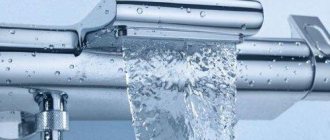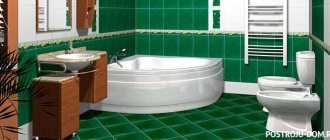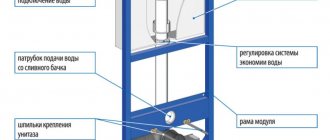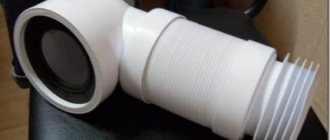I don’t want to imagine comfortable living conditions without such a plumbing fixture as a toilet. In order for it to function normally, the property owner must know its design features.
No matter what the toilet looks like, the filling in the cistern will be similar
How the toilet cistern works: the internal filling of the device
The normal operation of the drainage system is ensured through the interaction of its individual components. The water supply to the container is carried out thanks to the fill or inlet valve for the toilet. It is represented by a threaded pipe that is inserted into a hole in the side wall or bottom of the tank. The presence of a thread allows you to press the element to the tank wall using nuts, which will ensure a tight connection. Control over the opening and closing of the hole through which water enters is carried out by a locking mechanism connected to the rocker arm.
The principle of operation of the flush mechanism in the toilet cistern
The rocker arm is the lever that moves the exhaust valve. The free end of the element is attached to a float or control valve. A float is a plastic sealed container with air inside. At the moment when the float floats up or the shut-off device is activated, the rocker arm rises, which helps to close the gap in the filling valve or vice versa.
In normal condition, the drain hole is closed by the drain valve. This is a flat or hemispherical elastic gasket that connects the load-bearing part to the hinge mount.
The operation of the drain mechanism for the tank is controlled by a push-button or lever mechanism, which is located in the upper part of the tank. When exposed to it, its load-bearing part rises, opening a hole for water to flow at high speed into the toilet bowl.
All components of the mechanism can be arranged in different ways. In older models of tanks, the flushing and water overflow control mechanisms were mounted separately. In modern models, shut-off valves are presented as a single complex, which facilitates easy installation and configuration, while at the same time complicating repairs.
Water is supplied to the tank capacity through a fill or inlet valve
Repair of a built-in tank (with installation)
It is more difficult to get to the tank mechanism installed behind a false wall. First of all, you should purchase a device that is highly reliable and rarely requires repairs. There should be inspection hatches in the wall through which you can get to the tank and replace the gaskets if the seal is broken. It is not possible to repair the drain fittings yourself due to the complexity of the design.
A coarse filter is installed in front of the hidden tank, which captures solid particles, which in most cases cause leaks.
How a toilet flush mechanism should work
The flush mechanism for the toilet is located inside the tank. It does not have a complex design, but it performs important functions. The drain mechanism is responsible for draining water from the tank, filling the container with water, and controlling the water level, which eliminates the possibility of the tank overflowing when the liquid reaches a certain level.
The principle of operation of the drain tank is as follows. Water enters the container through a fill valve, which may be located in the wall or bottom of the tank. As the container fills, a shut-off device in the form of a float or valve is activated, which shuts off the supply of liquid when it reaches a certain level, blocking the filling valve.
When it becomes necessary to flush the water, the button or lever is pressed, which opens the shut-off valve of the toilet cistern. As a result, liquid enters the toilet bowl. Double button systems work similarly. When the small button is pressed, part of the water is poured out of the tank, when the large button is pressed, a complete drain is performed.
Important! The flush mechanism of the toilet tank with a button for two modes ensures water saving.
Water can enter the tank through a valve located in the bottom or wall
Draining the water entails a decrease in the liquid level in the container. This helps activate the control devices, as a result of which the outlet valve opens and the tank fills with water.
Flush
Based on the method of flushing, toilets are divided into direct cascade models. You can also select reverse circular models. Solutions have pros and cons.
It is rare, but it happens that manufacturers try to create non-standard drain systems, where the bowl is filled with water and quickly drains. In this way, the entire bowl is covered, but the owner will pay with high water consumption - it can be 8 liters or more.
If you read GOSTs and SNiPs, they will tell you exactly how the toilet is designed and what characteristics it should have. GOST standards state that the volume of the tank should be no more than 6 liters. However, modern drain systems operate in economical and maximum modes. In case of maximum operation, water consumption will be twice as large.
Other criteria for selecting equipment depend on the type of connection between the toilet and the sewer pipe in the apartment.
Flush types:
- Direct flush systems. Here the water flow will pass through only one part of the bowl. With general durability, it is impossible to ensure high-quality surface cleaning. The only advantage is accessibility. The main disadvantage, besides the incomplete coverage of the bowl, is noise and splashes.
- Circular flush. Several jets of water are directed at different angles to the inner surfaces of the bowl. Streams move in two directions. This allows you to process up to 95% of the entire bowl. During operation there is almost no noise or splashing water.
Types of drain fitting design for toilet cistern
There are several options for the drainage system. The filling valve can be bottom or side mounted. In the first case, the pipe is located in the bottom of the drain container. This system includes a vertical rod float, a rod and a buoy. The last two elements are connected into a common structure, which acts as a water limiter.
When the tank is empty, the float lowers. At this moment, draft begins to act on the toilet valve, opening it. When the float reaches a certain level, the valve closes. Sealing of the system is ensured by a pair of gaskets.
When placed on the side, the pipe with the valve is inserted into the tank through a side hole, which is located in the wall of the container under the lid. This gap is made conditionally sealed, since water does not reach it. In this design, the control mechanism of the flush tank is placed horizontally. It consists of a shut-off device, a float, a lever and a filling tube. When the tank is emptied, the float lowers, which moves a rod that opens the shut-off valve. When the tank is filled with water, the control mechanism gradually rises.
In a side-valve design, the mechanism is located horizontally
From the point of view of efficient and comfortable operation of the drainage device, it is better to choose models with a bottom connection, which are more reliable and make less noise when the container is filled with water. Systems with side connections are characterized by ease of installation and ease of adjustment and repair work.
Important! Tanks with bottom connections require close attention to the tightness of the connection.
The flush mechanism is activated by a trigger, which can be a lever, a rod or a toilet button. Older models were equipped with a lever to which a cord with a handle or a chain was attached. The drain system with a rod was activated by lifting the handle up. This option has also lost popularity and is rarely found in modern tanks.
Bottom-mounted designs are more reliable
Currently, models are most often controlled by pressing a button located in the tank lid. The push system, in turn, can be one-button or two-button. In the first case, the tank is completely emptied when you press the button. The second option involves two modes of operation of the tank drain mechanism with a button. The first ensures that half the volume of the container is drained, and the second ensures that the tank is completely emptied.
Communications
The drain tank is connected to the water supply using a rubber hose. They are equipped with O-rings and have brass nuts. This is the best variant. It is not recommended to use plastic pipes and similar nuts to connect communications. The design will be too flimsy and unreliable. Such products can be put into operation, but only as a temporary option.
The pipe is fixed on the side or bottom of the tank - it all depends on which side the cold water will be supplied from for draining. The lower mounting option is more preferable, since the process of filling the tank in this case is very quiet. And visually this design looks neater.
Types of toilet flush valve as a system overflow control mechanism
The toilet cistern flush valve can be a float or membrane shut-off device. Models of the first option may differ in structure and principle of operation. Old tanks were equipped with Croydon valves, which consisted of a body, piston, axle, seat and float lever. When the float lever was acted upon, the mechanism began to function. In this case, the piston moved vertically.
Most modern drain mechanisms are equipped with a piston valve, which moves horizontally when the lever is pressed. The water supply is regulated by the contact of the piston and the seat. When the container is filled, the inlet hole is closed using a gasket located at the end of the piston.
The diaphragm valve is not equipped with a piston gasket, but with a rubber or silicone membrane. When a lever acts on it, the plastic piston begins to displace the membrane, which closes the water supply.
The drain valve can be equipped with a membrane or float mechanism
Important! The diaphragm valve facilitates quick and silent filling of the tank.
The disadvantage of this element is the greater sensitivity of the product to dirt and the presence of impurities in water. The diaphragm valve will quickly lose its operational properties due to poor quality water in the system. A mechanical cleaning filter will help avoid problems.
There are floatless options for the drain system. The water supply to them is stopped due to the presence of a special chamber shaped like an inverted glass.
Material for making toilet flush valves
Expensive models of toilet flush systems are made of bronze or brass. These materials are characterized by strength, reliability, corrosion resistance, and the ability to withstand mechanical and chemical loads. The design can be either simple or complex. Metal filling is found in expensive collectible models, which are produced with a certain stylization.
Most drain valves are made from polymers
In other cases, bronze and brass can be used in the manufacture of only the fill valve, which makes the shut-off and drain system universal, easy to install, configure, repair, and allows you to replace each unit individually.
Many valve models are made from polymers. The quality of plastic and precision of production affect the cost of the product. The more expensive the fittings, the more reliable and durable the drainage system will be. However, there are high-quality models that have an affordable price.
Modern material
The bowl is made from a variety of materials:
- glass;
- metal;
- tree;
- plastic.
Step-by-step toilet installation diagram.
However, toilet bowls made from ceramics are most often offered for sale:
- sanitary porcelain;
- sanitaryware
These materials are very difficult to distinguish; sometimes even a professional cannot do it. Their cost is exactly the same. However, sanitary porcelain has more positive qualities:
- porosity;
- absorbs less dirt;
- eliminates odors.
To determine the type of material, you need to look at the catalog in the store. It usually indicates the type of material from which a particular model is made.
How to choose the right toilet parts
If elements of the drain system fail, it is important to choose the correct option that will correspond to the factory configuration. The units may differ in the material they are made of. Products made of bronze and brass are considered the highest quality and most durable. However, they are characterized by high cost.
The repair kit for the toilet is selected based on the model of the tank. Important parameters are the location of the inlet, its size, the diameter of the drain opening and the overall dimensions of the device, which must fit freely into the tank. The flush mechanism for a toilet can be represented by a single design or consist of separate (drain and fill) devices. The second option significantly facilitates and simplifies the process of replacing products.
If elements of the drain mechanism break down, the repair kit is selected based on the model of the tank
When choosing a valve, you should pay attention to the quality of the product. The mechanism must operate under its own weight. It is necessary that all its components are movable, move smoothly and unhindered. There should be no jamming of any kind.
When choosing a drain mechanism, you should carefully inspect the elements. They must have a solid body, free from chips and cracks, and the correct geometric shape, which will contribute to efficient and uninterrupted operation. Spare parts for toilets made from high-quality material have a high cost.
Seals and gaskets should be purchased from silicone. Such products, unlike rubber ones, are characterized by strength, reliability and durability. Elements are checked for compression and bending. They should not be deformed or cracked.
Helpful advice! The best performance and strength properties are provided by sealing elements, in the manufacture of which rubber is added to enhance elasticity.
New mechanism parts must be of high quality, without chips or cracks.
Hydraulic valve
The main principle of operation of this mechanism is the change in the parameters of atmospheric pressure, which is formed in the sewer system and riser. When the atmospheric pressure exceeds the sewer air pressure, the amount of liquid in the water seal begins to decrease, and a small part of it is sent to the riser.
The water seal inlet is almost always made in a vertical plane, its outlet is made at an angle of 90 ° or slightly inclined. If you do not use the water seal for a long time, the liquid may simply evaporate.
Dismantling and installation of the flush mechanism for the toilet cistern
If the drain mechanism fails, you can replace it with a new repair kit yourself. Replacing the flush mechanism in the toilet cistern is carried out according to the following algorithm.
Related article:
How to choose a toilet: main criteria and features of various models
Review of the 5 most popular manufacturers and models. Common breakdowns and ways to fix them.
The first step is to turn off the water supply. Next, press the drain button to empty the tank. It is carefully removed, which makes it possible to remove the tank lid. Then the water supply hose is disconnected. The nut that secures the filler pipe is unscrewed. You need to remove the part itself from the hole.
Helpful advice! Before changing the flush mechanism in a toilet cistern with bottom water supply, it is recommended to install a small container under the plumbing fixture into which the water that does not go down the drain will drain.
The internal fittings are removed from the tank and unscrewed from the fasteners. Next, unscrew the bolts securing the tank to the toilet bowl. The container is removed. After this, the lower part of the drain system is dismantled and the sealing gaskets are removed. After disassembly is completed, it is necessary to clean the inner surface of the tank and all its openings, remove plaque, debris and lime deposits.
After removing the internal fittings, it is necessary to unscrew the bolts securing the tank and toilet
Installation of the drain mechanism involves the reverse sequence of work. The lower part of the drain system is inserted into the hole, and sealing gaskets are attached. Next, install the flush cistern on the toilet and secure it with fastening bolts.
Important! If corrosion has formed on the old bolts, the elements should be replaced with new ones.
The internal part of the flush mechanism is installed in the toilet siphon. The fill valve should be inserted into the gap in the bottom or side wall of the tank, securing it with a nut and sealing gaskets. A water supply hose must be connected to the outlet pipe. The water is turned on and the system is checked for functionality.
If all elements are installed correctly and the joints are securely sealed, then there will be no leaks.
The filling valve is inserted into the side wall of the tank or into the bottom
Intake Valve Replacement
Before repairing the toilet, you should turn off the water supply valve. It is connected to the pipeline from the riser. Then the flexible hose is unscrewed from the inlet mechanism. It can be easily removed if the fastening is loosened. A new or repaired one is installed in its place. Assembly is carried out in reverse order. Plastic threads do not require sealing, and fluoroplastic tape is wound onto brass threads.
Testing the toilet flush system after installation
After installing or repairing the toilet cistern flush mechanism with a button, the system is tested. The first step is to check that there are no visible leaks. To do this, you need to run water through the plumbing fixture several times. Water should not flow into the toilet bowl unnecessarily, and you should also make sure that there are no leaks underneath. If they are detected, it is necessary to fix the fastenings as firmly as possible.
Next, it is checked whether the water level in the tank has reached the required level. If this does not happen, the toilet tank is adjusted. The filling valve should work normally and not stick. You can verify the quality of its operation by applying sharp downward or upward pressure to the mechanism.
Next, you need to evaluate the operation of the system by ear. If there is a hissing, whistling, or other sharp sound, this indicates that the flapper valve is closing. The problem is resolved by lowering or raising the element using a screw, which is driven by a screwdriver.
To ensure normal operation of the system, the water level in the tank is adjusted. The float, which is held in place by a thick wire, should be placed so that it is located 1-2 cm below the edge of the reinforcement. To gain more water, the metal lever needs to be bent in an arc downwards. To reduce the liquid level, the product is bent in the opposite direction.
After installing the drainage system, it must be tested
If the float lever is made of plastic, its adjustment is carried out by a special screw, which rotates until the float takes the desired position. The optimal level of liquid in the tank is considered to be at which the water will be 3 cm lower than the overflow hole.
The correct position of the buoy indicates that water does not overflow through the system and does not go into the toilet bowl unnecessarily. After adjustment, the lid is installed on the tank and secured with a button.
Plumbing tricks for convenience and comfort
Wanting to achieve greater comfort, people invent new devices that can improve their lives, eliminating the slightest moments that can cause irritation. For example, many people are annoyed by a falling toilet lid. That is, not even the fact of falling, but the sound that is made.
In this regard, a toilet lid microlift was invented not long ago. This mechanism has recently become increasingly popular and is gaining new fans. It allows you to eliminate the problem described above - the sound of a falling toilet lid. The microlift is not only silent, but also allows the lid to lower smoothly, without sudden movements. There is no need to control this process, which is also very convenient.
Thus, we examined the mechanism of operation of such an important piece of plumbing as the toilet. We learned how water is drained and plunged a little into the world of modern plumbing with its new products.
Possible system malfunctions and ways to eliminate them
Studying the principle of operation of the toilet will help identify possible malfunctions and eliminate them. If the overflow control does not work, you need to find the reasons that caused the damage to the system. The most common may lie in the misalignment of the lever or rocker arm that holds the float. It must be aligned, which will ensure the correct movement of the float and the restoration of the system.
For toilet flush systems with a membrane valve, when the element moves to the upper position, the hole may remain open. In this case, the position of the membrane is adjusted or replaced. The reason for the failure of the overflow control system may be perforation of the float with water ingress. This problem requires a complete replacement of the element. If the above operations do not resolve the malfunction, it is necessary to replace the inlet valve.
There are many reasons for a malfunctioning tank drain system.
A leak at the fill valve occurs primarily as a result of wear on the sealing gasket. In the early stages, the problem can be eliminated by tightening the fastening nut. In advanced cases, you will need to replace the gasket.
If the drain button does not work, the cause may be a misalignment of the lever that connects it to the drain valve. Such a malfunction may occur due to the breakdown of plastic elements of the internal fittings. In this case, replacement of the drain mechanism is required.
During the initial operation of the tank, problems may arise as a result of incorrect adjustment of the system. To ensure its functionality, it is necessary to select the height of the drain cup corresponding to the height of the tank, fixing it in the correct position.
If weak pressure is observed while filling the tank at normal pressure in the general system, the water supply hose is dismantled, cleaned, and lime deposits that have blocked the lumen are removed. If cleaning cannot be done, the hose is replaced with a new one.
A misaligned lever may cause the button to not operate.
If the problem is not resolved, you need to inspect the intake valve and check its functionality. To do this, open it, clean the inner chamber and adjust the overflow system. If the problem persists, the valve must be replaced.
Types of release into the sewer system
If we consider how the toilet is designed according to these parameters, then equipment is produced with vertical, horizontal, and also with oblique outlet. The choice of one design or another depends on the sewer inlet on the pipe in the apartment and its location.
Types of release:
- Oblique release. The system was widespread along with riser sewer systems - it was operated in the 80s.
- Horizontal release. Modern sewer systems are specially designed for the use of equipment with horizontal drainage. The connection between the toilet and the sewer pipe with an oblique outlet will not allow the installation of a toilet with a horizontal outlet - special adapter pipes will be needed.
- Vertical exhaust system. Vertical exhaust was widespread in buildings in the first half of the twentieth century. In modern construction, vertical discharge and sewerage underneath it are common in the USA. Communications are mounted there without being tied to the walls. This approach allows you to install a bathroom anywhere in the apartment. Pipelines are easily hidden behind wall or floor cladding.
Popular manufacturers of toilet cistern flush devices
One of the most famous manufacturers of plumbing products and spare parts for them is the Czech company Alka Plast. It produces high-quality, functional and durable products at an affordable price. A popular universal model is the AlkaPlast A2000 drain mechanism with a stop button function. The device is suitable for replacing the existing mechanism in ceramic tanks. Thanks to the special design, the height of the product can be adjusted within the range of 310-405 mm (depending on the height of the tank).
The device is equipped with a stop function button, which starts draining the water when pressed for the first time and stops it when pressed again. The mechanism is made of ABS plastic, which is resistant to abrasion and various types of loads. You can buy a drainage device for 850 rubles.
The Alka Plast A08A dual-flush drain mechanism has two modes of water release with a volume of 3 and 6 liters. The design of the device allows you to adjust the height of the drain mechanism within the range of 315-450 mm. The product is made of ABS plastic. The cost of the device is 1.1 thousand rubles.
The Czech company Alka Plast produces high-quality and durable drainage devices
Another equally popular manufacturer of toilet flush mechanisms is the Swiss company Geberit. The products of the global manufacturer are of high quality. The company is constantly improving its manufacturing methods for sanitary ware, introducing technological innovations.
Among the popular models of drainage systems, one can highlight the Geberit Impuls Basic 230 dual-flush mechanism, equipped with a chrome button. The device is made of durable high-pressure plastic, which increases its technical and operational properties. You can buy a flush mechanism for a Geberit toilet for 2.3 thousand rubles.
A high-quality model is the Geberit Impuls Type 290 drain mechanism, designed for two operating modes - drain for 3 and 6 liters. The device is intended for tanks with a height of 300-450 mm. The water supply can be carried out both from the side and from below. The cost of the Geberit drain mechanism is 2.8 thousand rubles.
The drain mechanism is a simple design. Having understood the principle of its operation and following the above tips, you can independently install, adjust and repair the device without completely replacing the toilet cistern.











